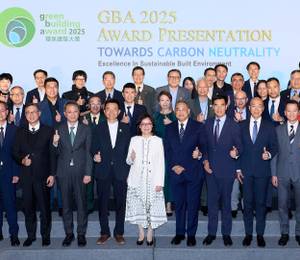Amsterdam, The Netherlands – Project H1 involves the transformation of an existing industrial site and railway area into a 504,000 square metres neighbourhood for the new digital economy.
As such, alongside the inclusion of a wide variety of layered private, semi-public and public programmes, UNStudio collaborated with the consultancy arm of UNSense to propose a plan for the integration of tailored, on-demand digital packages for the future residents.
This added tech layer is designed to complement the physical urban plan and create a fully digitally serviced neighbourhood - thus going beyond the usual efficiency focus of Smart City models to enhance the daily lives of the residents and free up time for leisure activities. This digital infrastructure can also be used for the management of energy production and consumption and of communal spaces, such as those cultivated for local food production schemes.
In the design, the different layers of the physical masterplan and the digital interface work together to provide residents of all ages and family configurations with a smart, healthy, green environment where contemporary working, living and entertainment are all combined in one neighbourhood; a productive neighbourhood of convenience, comfort and community. As such, Project H1 can serve as a pilot for an adaptable strategy for mixed-use urban developments of the future.
Project H1 will be a pedestrian-friendly neighbourhood with spacious streets and nature at your doorstep. It will be a place where residents have all the conveniences of the city within a 10-minute walk from their homes.
Ben van Berkel: “For the H1 masterplan we have aimed to create the ultimate contemporary 10-minute city, where the daily life experience of the residents is the top priority. We do this through the inclusion of a rich density of uplifting, curated on-site experiences that provide an extensive range of options for how they can spend their living, working and leisure time, thereby also saving them the time needed to travel elsewhere in the city - because with time that is saved, more time is created.”
H1 is a mixed-use neighbourhood that relies on System Design, where, rather than being fixed, certain components can be arranged according to different needs. As such, the masterplan incorporates various approaches to flexibility and adaptability across different typologies and scales.
Ben van Berkel: “We have taken an approach of ‘flexible urban density’. This enables the multi-functional use of public space and employs mixed-use organisational models to ensure that the residents can meet, connect and socialise, both in planned and spontaneous scenarios. The components of the masterplan not only encourage the creation of strong community bonds, the proposed digital service packages also create an unprecedented level of convenience for the residents.”
Amsterdam, The Netherlands – Project H1 involves the transformation of an existing industrial site and railway area into a 504,000 square metres neighbourhood for the new digital economy.
As such, alongside the inclusion of a wide variety of layered private, semi-public and public programmes, UNStudio collaborated with the consultancy arm of UNSense to propose a plan for the integration of tailored, on-demand digital packages for the future residents.
This added tech layer is designed to complement the physical urban plan and create a fully digitally serviced neighbourhood - thus going beyond the usual efficiency focus of Smart City models to enhance the daily lives of the residents and free up time for leisure activities. This digital infrastructure can also be used for the management of energy production and consumption and of communal spaces, such as those cultivated for local food production schemes.
In the design, the different layers of the physical masterplan and the digital interface work together to provide residents of all ages and family configurations with a smart, healthy, green environment where contemporary working, living and entertainment are all combined in one neighbourhood; a productive neighbourhood of convenience, comfort and community. As such, Project H1 can serve as a pilot for an adaptable strategy for mixed-use urban developments of the future.
Project H1 will be a pedestrian-friendly neighbourhood with spacious streets and nature at your doorstep. It will be a place where residents have all the conveniences of the city within a 10-minute walk from their homes.
Ben van Berkel: “For the H1 masterplan we have aimed to create the ultimate contemporary 10-minute city, where the daily life experience of the residents is the top priority. We do this through the inclusion of a rich density of uplifting, curated on-site experiences that provide an extensive range of options for how they can spend their living, working and leisure time, thereby also saving them the time needed to travel elsewhere in the city - because with time that is saved, more time is created.”
H1 is a mixed-use neighbourhood that relies on System Design, where, rather than being fixed, certain components can be arranged according to different needs. As such, the masterplan incorporates various approaches to flexibility and adaptability across different typologies and scales.
Ben van Berkel: “We have taken an approach of ‘flexible urban density’. This enables the multi-functional use of public space and employs mixed-use organisational models to ensure that the residents can meet, connect and socialise, both in planned and spontaneous scenarios. The components of the masterplan not only encourage the creation of strong community bonds, the proposed digital service packages also create an unprecedented level of convenience for the residents.”
















